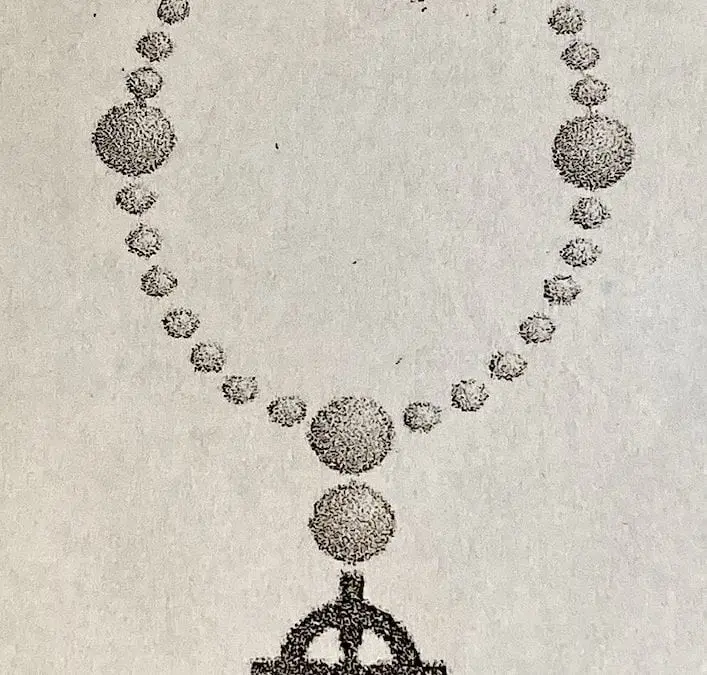The Triduum (Maundy Thursday, Good Friday and Holy Saturday) begins tomorrow with Maundy Thursday. The Triduum is comprised of three days where symbols of death and life are dramatic and poignant reminders of the fragility of life and can be a unique opportunity for Anglicans/Episcopalians – for anyone – to join religious traditions around the world who continue to use some form of prayer beads as part of their prayer life.
Since the earliest of times, people have used pebbles, a string of knots, or beads on a cord to keep track of their prayers offered to God. Anglican Prayer Bead necklaces (33 beads were created in the mid 1980s to help bring people into contemplative / meditation prayer and more intentionally be in the presence of the Holy One. Touching the fingers on each bead, is intentional. It is intended to help keep one’s mind from wandering and the rhythm of the prayers helps lead one into stillness.
Some background for those unfamiliar with Anglican Prayer Bead Necklaces. There are “names” for the thirty-three (representing the number of years of Jesus’ earthly life) beads which comprise the Anglican Prayer Bead necklace: “Weeks” – twenty eight beads divided into four groups of seven … seven to represent the seven days of the week. “Cruciform” – four beads between each ‘week’ helping to form an invisible Cross. “Invitatory” – the bead between the cruciform bead and the cross/medallion which acts as a call to worship and an invitation to a time of focused prayer. Some people add a bead above the Invitatory bead (the “Resurrection” bead) as a reminder that Christ lives on.
Praying the Anglican Prayer Bead necklace is often done
~ in an unhurried pace, followed by a period of silence with time for reflection and listening.
~ by praying around the circle of beads three times (representing the Trinity)
~ by using whatever prayers you choose for the beads in the Weeks, the four beads making the Cruciform, the bead between the Cruciform bead and the medallion/Cross … or simply by holding the beads/necklace in your hands as you pray.
How to pray using the Prayer Beads
~ no particular ‘format’ but some suggestions: Isaiah 41: 10-13 (at the beginning – holding the Cross/medallion); Isaiah 40: 29-31 (Cruciform beads); Matthew 11:28 (Weeks beads); Psalm 27: 1,3 (at the Cross) ; Psalm 29:11; the Lord’s Prayer; the Prayer of St. Francis; the prayer of Dame Julian of Norwich.
Over the years, many Anglican Prayer Bead necklaces have made their way from my home to others. I have found that in the making of them, yet another opportunity presents itself for me to enter into a contemplative mode. If you’d like to make your own, here are some simple steps:
~ Tape the end of thin, bendable wire or dental floss, cord or bead-making string
~ Choose twenty-eight beads that are similar to one another
~ String seven of those beads onto the wire, dental floss, string, using ‘spacers’ (ultra small beads) between the Weeks beads (number you use is optional as they are not counted as part of the Prayer Beads
~ Choose four different (a big larger helps) beads for the Crucifer beads
~ String one of the Cruciform beads onto the wire, floss, string
~ Continue the bead pattern of Weeks (spacers-optional), Cruciform
~ Choose a separate bead (the Invitatory bead – and spacer if desired)
~ String the Invitatory bead
~ Add a Cross, medallion, final bead.
~ Close off the necklace with jewellery endings or knot the two ends together
May this Triduum be a holy and meaningful moment in your spiritual journey as you consider the integration of Anglican Prayer Beads in your spiritual practice.
~~~~~~~~~~~~~~~
An aside: separate reflections for Maundy Thursday, Good Friday and Holy Saturday, (and when Easter arrives, for Easter Sunday and throughout the Season of Easter) will be available in the morning of their respective day. See the links below.
© June Maffin
https://soulistry.com
https://soulistry.com/blog
www.facebook.com/groups/soulistry

Discover more from Soulistry.com
Subscribe to get the latest posts sent to your email.

great
I loved this reflection, June!!! I did not know the structure and meanings behind the components of Anglican beads. (My history is rosary based). The idea of the beads being a necklace was totally new to me. Wow! Plus, directions to complete ones own!!! Thank u as always for your meaningful words and ideas. Wishing you a peace filled triduum.